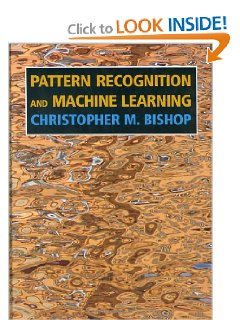Pattern Recognition and Machine Learning (Information Science and Statistics)by Christopher M. Bishop (Author). This is the primary textbook on sample recognition to present the Bayesian viewpoint. The e-book presents approximate inference algorithms that permit fast approximate answers in conditions the place exact answers are not feasible. It uses graphical models to describe likelihood distributions when no other books apply graphical models to machine learning. No earlier knowledge of pattern recognition or machine learning ideas is assumed. Familiarity with multivariate calculus and primary linear algebra is required, and a few experience in using probabilities can be helpful though not important as the ebook features a self-contained introduction to basic probability theory.
I was an enormous fan of Bishop's earlier "Neural Networks for Sample Recognition" regardless of my not being particularly eager about neural networks (versus other facets of machine learning), and so I used to be fairly excited when I heard about this book. Studying it has not left me disappointed. Like his earlier book, this textual content is sort of mathematically oriented, and not properly-suited to individuals who aren't snug with calculus. Nevertheless, additionally like in "NNPR", the writing model here may be very clear, and all the pieces past primary calculus and linear algebra is properly-defined before it is needed.
The appendices alone are a goldmine. (Appendix B is a great "cheat sheet" for generally used likelihood distributions; Appendix C has plenty of helpful matrix properties you might have forgotten or never recognized; Appendix D rapidly explains what you'll want to know about the calculus of variations; and Appendix E does the identical for Lagrange multipliers.) The writer additionally does an excellent job all through the textual content of marrying math and instinct without giving either brief shrift.
Nevertheless, be aware that the material lined is inherently fairly complex, so the ebook can nonetheless be intimidating in elements regardless of the wonderful writing. It's more applicable for, say, Ph.D. students and professional researchers in statistics or machine learning than people who simply wish to crank out code for a simple classifier.
There's very little pseudocode (though copious MATLAB code will supposedly be made out there in a companion e book due out in 2008), and the e-book's total strategy to machine studying is mainly exhausting-core Bayesian statistics. If you are not willing to scratch your head for some time over heaps and plenty of equations, this will not be the e book for you.
On the flip aspect, people who are already specialists in machine studying may be mildly disappointed with the shortage of coverage some of their pet matters get. For instance, whereas the chapter on graphical models is superb as far as it goes, it only mentions the problem of studying graphical mannequin buildings (one in all my areas of curiosity) in passing. Reinforcement studying (one other private area of curiosity) is mentioned briefly in the introduction after which written off as beyond the scope of the book.
Nonetheless, the guide is already a wonderful useful resource as it stands; complaining there's not much more of it could be gauche.
The quilt might appear like goat barf, and there are some innocuous lacking words right here and there (hey, it's a first edition), but for those who're serious about machine studying and not afraid of somewhat math, you need to definitely personal this book. I can solely think about how a lot cooler my very own thesis research may need been if this ebook had been round a couple of years earlier.
I began to read this e-book after I gave up the ebook "ingredient of statisitcal studying" which I examine 80 pages. I will not say that the latter guide EoSL is unhealthy, but it positively assumes a a lot higher math background. Additionally it would not give all of the derivations and reasonings, so it could take a long time to know a single paragraph. The studying is slow and frustrating. I read every chapter twice, however nonetheless don't think I did get it in my heart.
In contrast, the ebook "Pattern Recognition and machine studying" assumes a lot less math background, and usually offers full derivation and reasoning, which makes it a pleasure to read. Due to this fact, if you are not in statistics major (but a CS main with reasonable statistics background), I recommend you to begin this ebook.
Pattern Recognition and Machine Learning (Information Science and Statistics)
Christopher M. Bishop (Author)
738 pages
Springer (October 1, 2007)
.jpg)
No comments:
Post a Comment